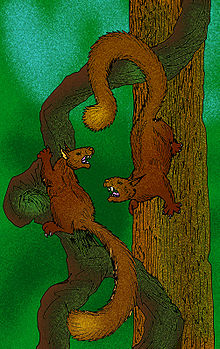| Archaic Mammals | ||
| The Vertebrates | "Cimolesta" |
| Vertebrates Home | Vertebrate | Vertebrate |
|
Abbreviated Dendrogram
Eutheria
├?─┬─Palaeoryctidae
│ └?─┬─Pantolesta
│ ?
│ ├─Ptolemaiidae
│ ?
│ ┌───┘
├─┴─Afrotheria
├?──┬─Pantodonta
│ └─Tillodontia
├?─Taeniodonta
├?─Dinocerata
╞?═Creodonts
├─Boreoeutheria
└─Xenarthra
|
Contents
Overview |
The Cimolesta are a group of poorly known late Cretacous and early Cenozoic mammals. Although Rose (2006), Kielan-Jaworowska et al. (2004), and McKenna and Bell (1997) included the type family Cimolestidae within the Ferae (carnivorous placental mammals), with Creodonts and Carnivora, Wible et al., 2007 and 2009 found it to fall outside the crown group Placentalia, related to the Asioryctitheria, such as are represented by Asioryctes, above . The current tendency also is to see the Creodonts as an artificial grouping. It is not even clear if the Cimolesta is a natural taxon, as it contains several groups such as the paraphyletic insectivorous Didelphodonta (which includes Cimolestes and the Cimolestidae) which as mentioned it seems now are not even placentals and so belong further stemward of the eutharian tree , the semi-aquatic Pantolesta, the medium to large herbivorous Pantodonta, and the enigmatic herbivorous Tillodontia and Taeniodonta (Rose 2006), along with a few other groups. Others that may or may not be related are the carnivorous Ptolemaiidae and the large to huge herbivorous Dinocerata . The Pholidota or pangolins (scaly ant-eaters) have been placed here as well, an assignment that seems extremely unlikely, at least if molecular phylogeny is reliable in placing the Pholidota (as the sister clade to the Carnivora, itself a morphologically unlikely grouping) with the Laurasiatheria whilst cladistics places the Cretaceous Cimolestidae outside the crown group placentals. Of course, it may well be that we are dealing with several totally unrelated groups here. But the possibility that stem eutharians, like multituberculates and marsupials, continued through to the Cenozoic is an intriging one, as is the purely hypothetical premise that such stem group eutheriuans constituted an important part of earliest (Paleocene to early Mid Eocene) mammalian faunas. The grouping on the present page should therefore be taken as purely tentative MAK111210

Range: Middle Paleocene to the Middle Eocene of North America and Europe
Phylogeny: Placentalia/Crown Group Placentalia ::: *
Comments: and diverse group that includes terrestrial, semi-aquatic, and arboreal mammals. In dentition they resembled the Placentalia, except that the teeth are specialised in ways that suggests greater emphasis on crushing and grinding, and hence adaptation to a hard (durophagous) diet. They were also larger, witha body length of around 50 cm. The skeleton where known is quite robust with a long, well-developed tail. Terrestrial forms had digging ability. Pantolestes from the middle Eocene of Wyoming, Buxolestes from Messel, Germany, and late early Eocene Palaeosinopa from the Green River Formation of Wyoming all have features convergent with otters and suggestinga semi-aquatic lifestyle. A prominent cranial crest combined with strong spinal processes, indicating the presence of strong neck muscles needed by swimmers that need to hold their heads above the water surface. Pantolestid may or may not have been related to the ptolemaiids and/or palaeanodonts
Reference: Rose 2006 p.99-103
Links: Paleocene Mammals, Wikipedia MAK111210
Image: Life reconstruction of Kopidodon macrognathus Wittich, 1898 a squirrel-like mammal of the family Paroxyclaenidae (related to Pantolestidae) known from the Messel lagerstatte (Middle Eocene of Germany). Much of the 115 centimeters length was taken up by the bushy squirrel-like tail (the outline of fur has even been preserved). Artwork by Stanton F Fink (Creative Commons Attribution Share Alike, GNU Free Documentation, via Wikipedia
Range: latest Eocene to Miocene of Northern and Eastern Africa
Phylogeny: Placentalia/Crown Group Placentalia or Afrotheria, ::: *
Comments: First known from a set of isolated molar teeth, they were originally identified as primate. Later, when the first skull was found, it was then thought to be a huge, wolf-sized shrew. Similarities between dental and skull anatomies with those of Pantolesta. Alternatively they have been also assigned to the Afrotheria, as the taxon was endemic to Paleocene Africa, and because of some similarities in skull anatomical features in common with those in aardvarks. Generally placed in their own order, distinct from other mammals (Simons & Bown 1995) The oldest fossils are from the latest Eocene strata of the Jebel Qatrani Formation, near the Fayum oasis in Egypt. The youngest known ptolemaiid, Kelba, dates from the early Miocene of Eastern Africa. (Cote et al 2007)
Links: Wikipedia MAK111210
Page MAK120315